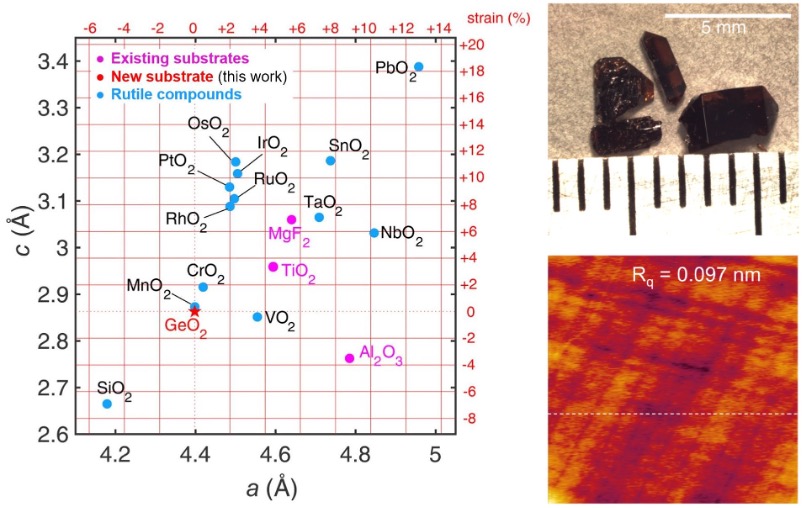PARADIM Highlight #64—External User Project (2022)
J.T. Heron, E. Kioupakis and R. Hovden (University of Michigan), L.F. Kourkoutis (Cornell University). and T.M. McQueen (Johns Hopkins University)
Materials discovery is more than calculating the properties that a material should have if the atoms were in desired positions. It is also key to realize the material and control the type, number, and distribution of imperfections to maximize performance. Rutile compounds have exotic functional properties that can be applied for various electronic applications; however, the limited availability of epitaxial substrates has restricted the study of rutile thin films to a limited range of lattice parameters.

Figure 1: Rutile GeO2—a promising material—Identified by theory—Realized in thin film and bulk form. (left) Lattice parameters of rutile compounds. Only three rutile substrates are commercially available (pink). The grid line indicates misfit strain with respect to GeO2 substrates. (right top) Photograph of r-GeO2 single crystals synthesized by the flux method. Crystal sizes reach up to 4 mm. (right bottom) Atomic force microscopy image of a r-GeO2 single-crystal substrate after surface planarization by mechanical polishing and annealing.
Here, a team from the University of Michigan came to PARADIM to grow single crystals of rutile-GeO2 motivated by their recent discovery of this new semiconductor—with an ultra-high band gap (4.64 eV), high mobility, high heat conductivity, and desired dopability.
Rutile GeO2 single crystals with high crystallinity are grown by the seeded flux method and, after mechanical polishing, a surface roughness of less than 0.1 nm was obtained. Finally, epitaxial growth on the new rutile GeO2 substrates was demonstrated at PARADIM’s molecular beam epitaxy (MBE). Templating by GeO2 substrates opens the possibility of stabilizing new rutile thin films and strain states for the tuning of physical properties.
Rutile compounds have exotic functional properties that can be applied for various electronic applications; however, the limited availability of epitaxial substrates has restricted the study of rutile thin films to a limited range of lattice parameters. Here PARADIM users from the University of Michigan demonstrate rutile GeO2 as a new rutile substrate with lattice parameters of a = 4.398 Å and c = 2.863 Å. Substrate size rutile GeO2 single crystals are grown by a seeded flux method. X-ray diffraction reveals high crystallinity with a rocking curve having a full width half-maximum of 0.0572°. After mechanical polishing, a surface roughness of less than 0.1 nm was obtained, and reflection high-energy electron diffraction shows a crystalline surface. Finally, epitaxial growth of (110)-oriented TiO2 thin films on GeO2 substrates was demonstrated using molecular beam epitaxy.
Our findings open the possibility of stabilizing new rutile thin films and strain states for the tuning of physical properties: substrate-sized and quality rutile GeO2 single crystals opens a new range of accessible lattice parameters for the development of high-power electronic devices.
This work made use of the flexible crystal pulling capabilities within PARADIM’s Bulk Crystal Growth facility, along with the knowledge to optimize synthesis conditions for suitable single crystals. The suitability for the single crystals as substrates for MBE was demonstrated through use of PARADIM’s oxide MBE facility.
The project was initiated by scientists from University of Michigan combining partners from theory and experiment, wherein PARADIM enabled the successful realization of the single crystals and its first application as substrate for thin film growth.
S. Chae, L.A. Pressley, H. Paik, J. Gim, D. Werder, B.H. Goodge, L.F. Kourkoutis, R. Hovden, T.M. McQueen, E. Kioupakis, and J.T. Heron, "Germanium Dioxide: A New Rutile Substrate for Epitaxial Film Growth," J. Vac. Science & Technol. A 40, 050401 (2022).
This work was supported by the National Science Foundation [Platform for the Accelerated Realization, Analysis, and Discovery of Interface Materials (PARADIM)] under Cooperative Agreement No. DMR-2039380. S.C. acknowledges support from Rackham Predoctoral Fellowship. This work made use of the Cornell Center for Materials Research (CCMR) Shared Facilities, which are supported through the NSF MRSEC Program (No. DMR-1719875). The Thermo Fisher Helios G4 UX FIB was acquired with support by NSF No. DMR-1539918. The Thermo Fisher Spectra 300 X-CFEG was acquired with support from PARADIM and Cornell University.
Data Availability: Raw data are available at https://data.paradim.org/214 provided by the PARADIM Data Collective.







